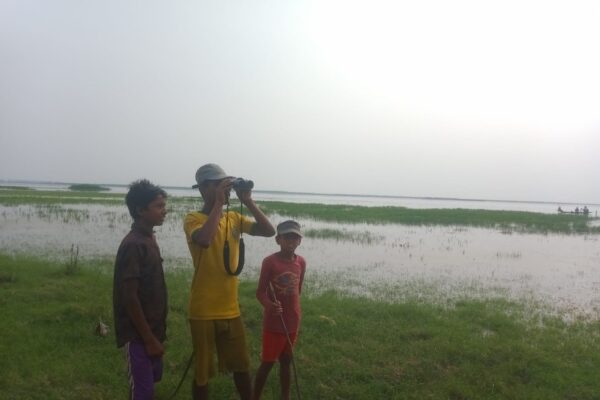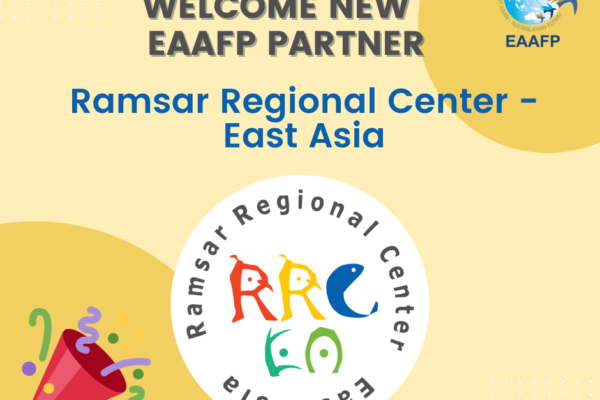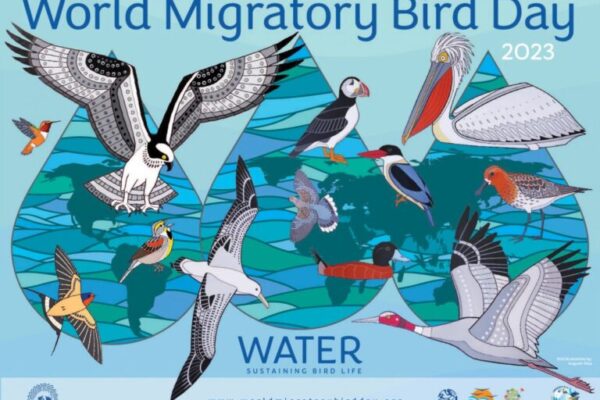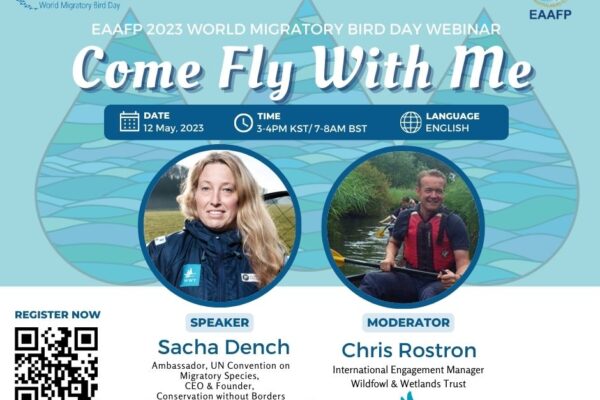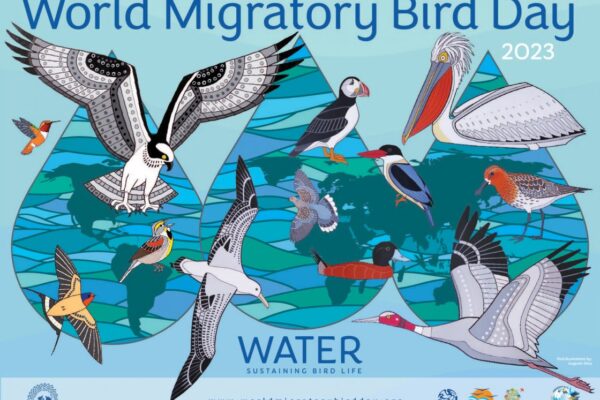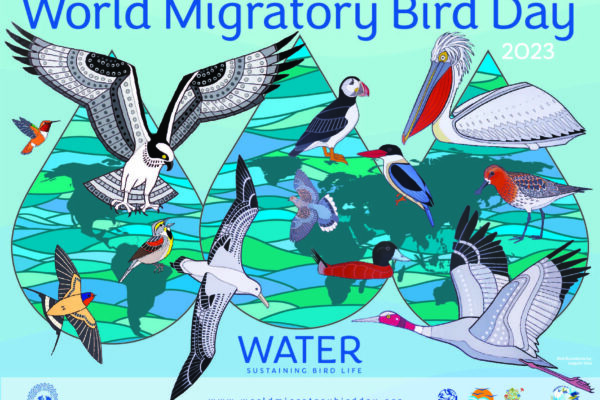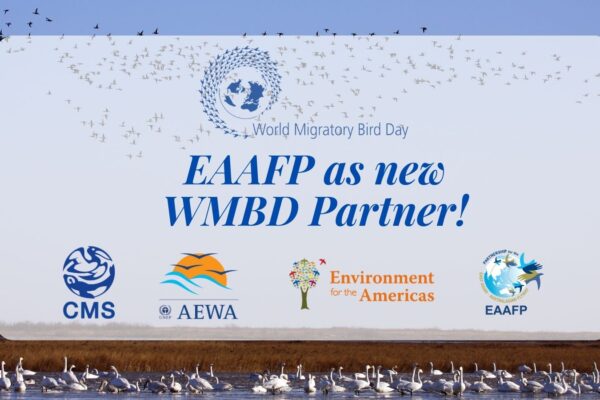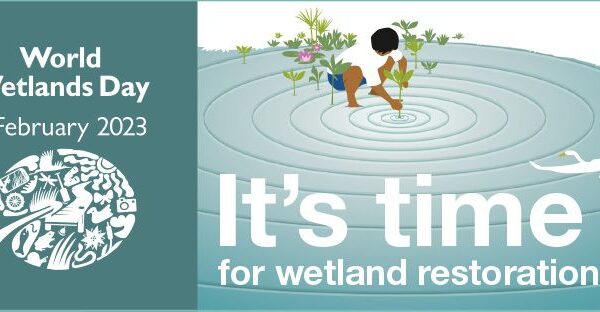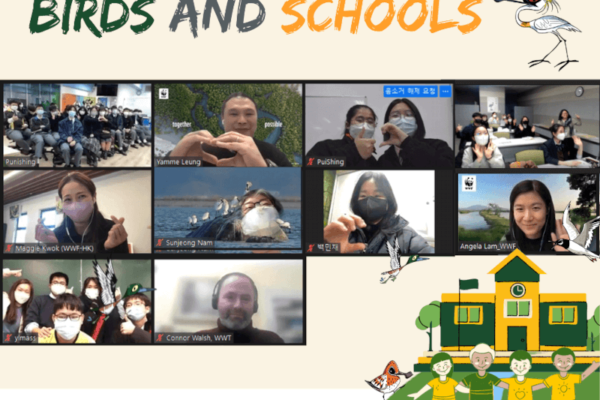-
Strengthening Public Awareness: 2023 World Migratory Bird Day Celebrated in Tanguar Haor, Bangladesh
Nature Eye, a renowned conservation organization, successfully organized the World Migratory Bird Day (WMBD) 2023 event at Joypur Government Primary High School in Tanguar Haor, Bangladesh. This significant celebration took place on 13th May, 2023, with the support of the East Asian-Australasian Flyway Partnership (EAAFP). The event aimed to raise awareness about the conservation of migratory birds and their habitats, educate participants about wetland importance, and promote the protection of Tanguar Haor—an EAAFP Flyway Network Site and a Ramsar Site. A total of 377 participants, including school students, teachers, and parents from the local community joined the event. A screening of an enlightening documentary titled "Migratory Birds of Tanguar Haor, Bangladesh", which shed light on the diverse avian species found in the region was shown. The documentary explained the migration patterns and emphasized the importance of Tanguar Haor as a crucial habitat for globally threatened and near-threatened species to the audience. Screening of the documentary "Migratory Birds of Tanguar Haor, Bangladesh" © Nature Eye One of the highlights of the event was the birdwatching activity. Students eagerly participated in observing migratory birds, honing their skills in bird identification. Equipped with binoculars, the participants were captivated by the experience of birdwatching, deepening their appreciation for the avian wonders that grace Tanguar Haor. Birdwatching activity at Tanguar Haor © Nature Eye Another important aspect of the event was a lecture on the significance of water for migratory birds, which was the theme of the 2023 WMBD. Participants learned about the crucial role of water habitats in the life cycles of these birds. Wetlands, rivers, lakes, and other water bodies provide essential resources for feeding, drinking, breeding, and rest during their arduous journeys. However, these habitats face threats from human activities, pollution, and climate change. The participants were made aware of the need to protect these vital ecosystems for the conservation of migratory birds. The alarming decline in migratory bird populations visiting Tanguar Haor was also discussed, attributed to factors such as habitat degradation, human pressure, illegal hunting, and water pollution caused by coal collection. Thousands of boats continuously pollute the water, endangering the foraging and roosting grounds of migratory waterbirds. This revelation emphasized the urgency of striking a balance between conservation and sustainable utilization of wetlands. Students participating in the art competition © Nature Eye Students showing their drawings © Nature Eye The event concluded with the students’ art competition where they drew the migratory birds found in Tanguar Haor. The successful celebration of WMBD 2023 in Tanguar Haor by Nature Eye would leave a lasting impact on the participants. They gained a deeper understanding of the ecological importance of migratory birds and wetlands while becoming advocates. The project was funded through the 2023 EAAFP WMBD Small Grant Fund. View the report, Click here. Article prepared by Nature Eye.
Continue reading -
Welcome Ramsar Regional Center – East Asia (RRC-EA) as EAAFP’s 40th Partner!
Today, the East Asian-Australasian Flyway Partnership (EAAFP) is delighted to announce the Ramsar Regional Center – East Asia (RRC-EA) as its 40th Partner. This new partnership would enhance collaborative effort, especially on CEPA (Communication/Capacity Building, Education, Participation and Awareness) on wetlands and migratory waterbird conservation in the Asian region of the East Asian – Australasian Flyway. RRC-EA is one of the Ramsar Regional Initiatives adopted by the Ramsar Convention. Based in Suncheon City of the Republic of Korea, it was established through the initiative of the Ministry of Environment (MOE) of the Republic of Korea to serve as a regional platform for capacity building, information exchange, and cooperation among governments, Ramsar Sites and wetland managers and stakeholders, international and national non-government organizations, technical experts and business organizations. One of the primary areas of focus for the RRC-EA is to build capacity and provide technical assistance to countries in the region to build capacity in wetland management, and to develop CEPA programmes. It leads the development of a regional CEPA strategy to raise awareness and promote the value of wetlands and their conservation in the region, including the development of Wetlands Link International (WLI) - Asia-Oceania, a network of wetland centres that promotes the sharing of knowledge, experience, and best practices in wetland conservation and management. With their focus aligning with the EAAFP's mission, RRC-EA has been actively collaborating with the EAAFP for many years, and their partnership was officially strengthened in December 2020 when they signed a Memorandum of Understanding (MoU) (link). The MoU aims to strengthen cooperation in common activities in the field of wetland conservation, especially on the expansion of cooperation and co-organization of capacity building, training and awareness-raising to relevant stakeholders at regional and national levels. Celebrating the new partnership, Mr. Suh Seung Oh, Executive Director of the Ramsar Regional Center - East Asia stated, "We are honored to become the 40th partner of the East Asian-Australasian Flyway Partnership. Wetlands are crucial habitats for migratory waterbirds, and our collaboration will enable us to work together more effectively to conserve these ecosystems and the waterbirds that depend on them. We look forward to sharing our expertise in wetland conservation, to promote and raise awareness of the importance of wetland conservation." The RRC-EA's expertise in wetland conservation and CEPA programs will be a valuable asset to the partnership's efforts to conserve migratory waterbirds and their habitats along the East Asian-Australasian Flyway. Visit RRC-EA's homepage: http://rrcea.org/
Continue reading -
World Migratory Bird Day 2023 highlights impact of the growing water crisis on migratory birds
BOULDER/BONN/INCHEON, 13 May 2023 – Water and its importance to migratory birds – and the increasing threats to both water quality and quantity - is the focus of this year’s World Migratory Bird Day, a global campaign that aims to raise awareness of migratory birds and the need for international cooperation to conserve them. Activities to mark the campaign will be held globally on two peak days in May and October under the theme “Water: Sustaining Bird Life” Water is fundamental to sustaining life on our planet. Migratory birds rely on water and its associated habitats—lakes, rivers, streams, ponds, swamps, marshes, and coastal wetlands—for breeding, resting, refueling during migration, and wintering. Yet increasing human demand for water, along with climate change, pollution, and other factors, are threatening these precious aquatic ecosystems. Headlines around the world are sounding alarm: 35 percent of the world’s wetlands, critical to migratory birds, have been lost in the last 50 years. Utah’s Great Salt Lake, the largest saltwater lake in the Western Hemisphere and used by more than a million shorebirds, is in danger of disappearing within five years. Across the Amur-Heilong Basin in Asia, climate change is amplifying the impact of habitat destruction by depleting natural water systems and depriving migratory birds of vital breeding and stopover site. These sobering examples go hand-in-hand with recent reports that reveal that 48 percent of bird species worldwide are undergoing population declines. Another poignant example is that of the Aral Sea shared by Kazakhstan and Uzbekistan. Once the fourth-largest lake in the world, it is widely regarded as one of the planet’s worst water-related environmental disasters. Soviet-era irrigation projects almost completely dried up the lake, which led to the loss of livelihoods for fishermen and farmers and the deterioration of public health due to toxic dust and reduced access to clean water. The impact has been severe for the communities around the lake, but also for migratory birds, which lost important food sources and a critically important stopover point on their journey. Another example is the Sahel, a vast semi-arid region in Africa: Prolonged periods of drought, deforestation, and overgrazing in the Sahel have led to the degradation of the soil and loss of vegetation, threatening the survival of both the local human population and wildlife, including migratory birds. Lake Chad, one of the largest water bodies in Africa in 1960, lost 90 % of its area, depleting water resources for local communities and also for many migratory birds. World Migratory Bird Day serves as an international call to action for the protection of migratory birds, whose ranges often span multiple countries, and are facing many different threats worldwide. The annual campaign is organized by the Convention on the Conservation of Migratory Species of Wild Animals (CMS), the African-Eurasian Migratory Waterbird Agreement (AEWA), Environment for the Americas (EFTA), and the East Asian-Australasian Flyway Partnership (EAAFP). World Migratory Bird Day 2023 will be officially held on 13 May and 14 October. The two days of World Migratory Bird Day reflect the cyclical nature of bird migration as well as the fact that there are varying peak migration periods in the northern and southern hemispheres. Events to raise awareness of migratory birds and the importance of water will take place all over the world including in local parks, nature centers, museums, libraries, schools, and other locations on these peak days and throughout the year. To learn more about this year’s World Migratory Bird Day campaign and actions to take, visit www.worldmigratorybirdday.org and EAAFP WMBD 2023 webpage: https://www.eaaflyway.net/world-migratory-bird-day-2023/ Also, please have a look of the Campaign Strategy for promoting World Migratory Bird Day, click [here]. For more resources, visit the Trello Board [here]. Message from the Partners of World Migratory Bird Day Convention on Migratory Species (CMS) “Water is essential for people as well as for migratory birds and other wild species of animals. Yet around the world, the availability and quality of water is under enormous pressure, with deeply concerning implications. The looming global water crisis requires urgent action by governments, businesses, local communities as well as individuals. Because migratory birds cross national borders and even continents, international cooperation is essential to ensure that actions are taken to conserve and restore important habitat for migratory birds, and to address the drivers of water loss, pollution, and climate change,” said Amy Fraenkel, Executive Secretary of the Convention on the Conservation of Migratory Species of Wild Animals (CMS). African-Eurasian Migratory Waterbird Agreement (AEWA) “The water crisis recently highlighted by the UN 2023 Water Conference also has a tremendous impact on migratory birds. In the Sahel in particular, many wetlands on which migratory waterbirds rely during the non-breeding period are shrinking. Water is a vital resource for all, local communities as well as birds. By reducing our consumption, combatting climate change, and managing wetlands wiser, we can improve the situation,” said Dr. Jacques Trouvilliez, Executive Secretary of the Agreement on the Conservation of African-Eurasian Migratory Waterbirds (AEWA). Environment for the Americas (EFTA) “World Migratory Bird Day 2023 spotlights the vital role that water plays in the survival of our shared birds. The focal species illustrated on the campaign poster depict the intricate bond each bird shares with water. The diminutive Rufous Hummingbird thrives on nectar-producing flowers that rely on water for their blooms, and the Dickcissel scours the grasslands for seeds that hold the moisture they need. White Pelicans and Ospreys seek their prey in freshwater lakes, while the magnificent Wandering Albatross and Atlantic Puffin remain at sea. WMBD is an opportunity to unify our voices for the conservation of migratory birds and to celebrate their spectacular journeys,” said Dr. Susan Bonfield, Executive Director at Environment for the Americas (EFTA). East Asian-Australasian Flyway Partnership (EAAFP) “This year's WMBD theme serves as a vital reminder of the linkage of migratory birds to the importance of protecting aquatic ecosystems and conserving wetlands. As birds such as threatened Spoon-billed Sandpiper, Dalmatian Pelican, and Sarus Crane migrate, they rely heavily on wetlands for survival. We must take urgent actions and collaborate at all levels, from citizens to among governments, to tackle the problems of saving water and aquatic ecosystem, and ensure that migratory birds continue to thrive.” Ms. Yeounhee Ahn, Deputy Executive of East Asian-Australasian Flyway Partnership (EAAFP).
Continue reading -
Come Fly with Sacha Dench, Human Swan -to celebrate World Migratory Bird Day
Brief Introduction Have you thought of flying with the migratory waterbirds, and even helping to save them from extinction? The theme of World Migratory Bird Day 2023 “Water: Sustaining Bird Life” highlights the importance of water for migratory birds and identifies key actions for protecting water resources and aquatic ecosystems. On 12 May, we are honoured to invite Ms. Sacha Dench, aka "Human Swan", Ambassador, UN’s Convention on Migratory Species, CEO and Founder of Conservation without Borders to share with us her exciting flying journeys to raise awareness of the conservation of migratory birds, and invite the audience to discuss new ideas with Sacha to the call for conservation actions! Date/Time: 12 May, 2023 (Friday) (15:00 – 16:00 KST/6:00-7:00 GMT/7:00-8:00 BST) Venue: Zoom Language: English Registration: https://us02web.zoom.us/meeting/register/tZYocuChqjksGtQp0-YfuilaqDOKW06K5_GM Speaker Sacha Dench Ambassador, UN’s Convention on Migratory Species; CEO, Founder of Conservation without Borders Sacha Dench is an Australian-born biologist who graduated from the University College of London and the current UN’s Convention on Migratory Species. She is the founder of Conservation Without Borders, which looks out for migratory species and issues that most need help. She is a conservationist, adventurer, and a motivational speaker having presented TED talks about her work in conserving different wildlife species across the world. She has worked for international conservation organizations in communications for more than 15 years. Q & A Moderator Chris Rostron International Engagement Manager, WWT (Wildfowl & Wetlands Trust) Chris has been working in wetland conservation and environmental CEPA activities for over 30 years. He is now based at the Wildfowl and Wetlands Trust (WWT), UK, working as the International Engagement Manager, particularly engagement in CEPA activities. For the past 12 years, he has led on WLI, the global network of wetland centres, supporting delivery of CEPA activities at wetland sites. He has worked closely with the Ramsar convention, supporting their CEPA programme, and actively engaging at their COPs, CEPA oversight panel and Standing Committees, allowing him to influence and support global wetland conservation. Support: Learn more about EAAFP activities and materials on World Migratory Bird Day: https://www.eaaflyway.net/world-migratory-bird-day-2023/ For inquiries, please contact Ms. Vivian Fu, Senior Communication Officer of EAAFP Secretariat, at communication@eaaflyway.net.
Continue reading -
EAAFP Foundation protects Sura Tidal Flat with Film
Special Screening On April 15, a special screening of the film <Sura> organized by EAAFP…
Continue reading -
World Migratory Bird Day 2023
What is World Migratory Bird Day? The World Migratory Bird Day (WMBD) is an annual global awareness-raising campaign to celebrate the amazing journeys of migratory birds, and to inspire worldwide conservation of migratory birds and their habitats. Traditionally observed on the second Saturday of May and October, the two days of World Migratory Bird Day are a way to reflect the cyclical nature of bird migration as well as the fact that there are varying peak migration periods in the northern and southern hemispheres. In 2023, WMBD will be celebrated on 13th May and 14th October. The campaign is a joint effort of the Convention on the Conservation of Migratory Species of Wild Animals (CMS), the African-Eurasian Migratory Waterbird Agreement (AEWA), Environment for the Americas and the EAAFP. On 17th March, the East Asian-Australasian Flyway Partnership (EAAFP) was announced as an official Partner of the World Migratory Bird Day campaign during the 11th Meeting of Partners (MOP11) of the EAAFP held in Brisbane, Australia (link). The new Partnership unites efforts to raise awareness to conserve migratory birds globally. Official website of World Migratory Bird Day: https://www.worldmigratorybirdday.org/ The Theme of World Migratory Bird Day 2023 The theme of World Migratory Bird Day 2023 is “Water: Sustaining Bird Life”. Water is fundamental to life on our planet. The vast majority of migratory birds rely on aquatic ecosystems during their life cycles. Inland and coastal wetlands, rivers, lakes, streams, marshes, and ponds are all vital for feeding, drinking, or nesting, and also as places to rest and refuel during their long journeys. On the other hand, aquatic ecosystems are becoming increasingly threatened around the world due to increasing human demand for water, integrating with problems of pollution and climate change. This imposes direct impacts on the availability of clean water and migratory birds that depend on them. This year’s World Migratory Bird Day campaign will highlight the importance of water for migratory birds and identify key actions for protecting water resources and aquatic ecosystems. Check the Campaign Strategy for promoting World Migratory Bird Day, click [here]. WMBD 2023 Press release, visit [here]. Learn about the EAA Flyway species featured on the 2023 WMBD poster Spoon-billed Sandpiper Scientific name: Calidris pygmaea Conservation status: IUCN - Critically Endangered, CMS - Appendix I Spoon-billed Sandpiper is the rarest shorebird and endemic to the East Asian - Australasian Flyway (EAAF). Listed as Critically Endangered on the IUCN Red List. It is a small shorebird with a peculiar spoon-shaped beak, thus nicknamed as “Spoony”. It breeds in the Arctic region in Russia Far East and winter at coasts in Southeast Asia. It is threatened by habitat loss and degradation, hunting and pollution at the wetlands. https://www.eaaflyway.net/spoon-billed-sandpiper/ Dalmatian Pelican Scientific name: Pelecanus crispus Conservation status: IUCN - Near Threatened, CMS - Appendix I The Dalmatian Pelican is a large waterbird and the biggest in the Pelican species. It has a big white body and a distinctive beak with an orange or yellowish gular pouch. The bird is a short-to-medium-distance migrant. Its distribution span across Central Eurasia to southern China coast. Hunting, habitat degradation due to wetland alteration and destruction are the main threat it is facing. Photo by Dean (Yu Deng, 邓郁) [copyright pending correction] https://www.eaaflyway.net/dalmatian-pelican/ Sarus Crane Scientific name: Grus antigone Conservation status: IUCN - Vulnerable, CMS - Appendix II Sarus Crane is a short-distance migrant with a bright red head and upper neck. They are inhabitants in wetlands and agriculture fields. There are populations rangingfrom India and Pakistan, Lower Mekong Basin including Myanmar, Vietnam, Cambodia Thailand, and a Australian population. They are vulnerable due to water diversions and unsustainable conversion of wetlands, habitat loss and other human disturbances. https://savingcranes.org/learn/species-field-guide/sarus-crane/ Join the WMBD Celebration Register your event on the Global Portal https://www.worldmigratorybirdday.org/register-your-event Resources for World Migratory Bird Day 2023 EAAFP World Migratory Bird Day 2023 Small Grant The Small Grant for 2023 World Migratory Bird Day (WMBD) has been established to provide financial support for EAAFP Partners and collaborators from EAAFP Task Forces and Working Groups, who plan on organizing public events and/or conservation action-oriented workshops at national or local levels for World Migratory Bird Day. We strongly encourage EAAFP Partners and collaborators to make an application for any suitable event or development of WMBD materials in local languages, that aims to raise awareness of the need of conserving migratory waterbirds and the value of their habitats in the East Asian – Australasian Flyway. For details, visit here. Deadline of applying for the WMBD October event: 31st August, 2023. World Migratory Bird Day 2023 Trello Board You can download everything from WMBD 2023 Trello Board [here]. World Migratory Bird Day 2023 Activities Come Fly With Me - 2023 World Migratory Bird Day Webinar with Sacha Dench Date/Time: 12 May, 2023 (Friday), 1500-1600 KST/0600-0700 GMT Meeting Platform: Zoom Language: English Registration: https://us02web.zoom.us/meeting/register/tZYocuChqjksGtQp0-YfuilaqDOKW06K5_GM More information, click [here]. You are invited to join the EAAFP Team on 13 May for the Global Big Day by eBird !! Be part of our Team to record migratory waterbirds in #EAAFlyway! Register an eBird account Go out and watch birds, keep count of the birds you see Submit your checklist to eBird and SHARE with "EAAFPTeam"! EAAFPTeam profile: https://ebird.org/profile/MzgyMzk1NA Benefit: Online version of "Birds of the World" will be FREE ACCESS starting 12th to 15th May!!! Materials for WMBD 2023 2022 WMBD Theme and Posters in EAAF Languages Languages Theme World Migratory Bird Day Poster links English Water: Sustaining Bird Life World Migratory Bird Day PDF Burmese ငှက်မျိုးစိတ်များ တည်တံ့ဖို့၊ ရေအရင်းအမြစ်များ ထိန်းသိမ်းစို့ ကမ္ဘာ့ရွှေ့ပြောင်းငှက်နေ့ PDF Bengali জলাশয় সংরক্ষণ নিরাপদ করে পাখির জীবন। বিশ্ব পরিযায়ী পাখি দিবস PDF Chinese (Simplified) 水:鸟类生命之所系 世界候鸟日 PDF Chinese (Traditional) 水:鳥類生命之所繫 世界候鳥日 PDF Filipino Tubig: Daluyang Búhay ng mga Ibon Pandaigdigang Araw ng mga Ibong Dayo PDF Indonesian Air: Menopang Kehidupan Burung Hari Migrasi Burung Sedunia PDF Japanese 鳥たちの命を支える水 世界渡り鳥の日 PDF Khmer ទឹកជួយទ្រទ្រង់ដល់និរន្តរភាពជីវិតសត្វស្លាប ទិវាសត្វស្លាបទេសន្តរប្រវេសន៍ពិភពលោក PDF Korean (DPRK) 세계철새의 날 Korean (RoK) 물: 새의 삶을 유지하다 세계 철새의 날 PDF Malaysian (Bahasa Malaysia) Air: Melestarikan Kehidupan Burung Hari Burung Hijrah Sedunia PDF Mongolian УС: Шувуудын Амьдралыг Тэтгэe Дэлхийн нүүдлийн шувуудын өдөр PDF Russian ВОДА: источник жизни птиц Всемирный день перелётных птиц PDF Thai วันนกอพยพโลก Vietnamese Nước: Duy trì sự sống của các loài chim Ngày chim di cư thế giới PDF Please contact us if you need raw design files to print or convert for your own local campaign. EAAFP Secretariat E-mail: wmbd@eaaflyway.net / communication@eaaflyway.net
Continue reading -
World Migratory Bird Day 2023 Global Campaign Poster Unveiled
We are pleased to present the 2023 World Migratory Bird Day global campaign poster. Featuring the work of Nicaraguan artist Augusto Silva, the poster shows twelve species that help tell the story of the importance of water to migratory birds. The selected bird species remind us that birds and many other species need wetlands for migration, wintering, and breeding. Some birds require specific types of water habitats, such as the tidal flats that Spoon-billed Sandpipers use during migration and winter, the mangrove forests and other coastal areas favored by Black-capped Kingfisher, open water for Dalmatian Pelican and Maccoa Duck to breed and the seasonally flooded fields in which the Sarus Crane uses. Water is essential for the survival of insects pursued by the Barn Swallow, the growth of nectar-producing plants frequented by the Rufous Hummingbird, and the health of grasslands inhabited by the Dickcissel and riverine forests used by the European Turtle Dove. The Atlantic Puffin and Wandering Albatross represent the oceans that make up 97% of all water on earth and are becoming increasingly polluted with chemicals and plastic waste. And finally, the Osprey serves as a conservation success story, reminding us that bird population declines can be reversed when we work together to conserve and protect our planet. The poster supports the theme of this year’s World Migratory Bird Day, which is “Water: Sustaining Bird Life,” a call of attention to the importance of water and its associated habitats to migratory birds. Unfortunately, increasing human demand for water, as well as human-driven pollution and climate change, threaten many of the water areas on which migratory birds depend. World Migratory Bird Day raises awareness of these issues and serves as a call to action for the protection of birds and their habitats. The two peak days of World Migratory Bird Day 2023 will be 13 May and 14 October, reflecting the cyclical nature of seasonal bird migrations. Events will take place all over the world in parks, nature centers, museums, libraries, schools, and other locations on those two peak days as well as throughout the year. To find an event near you, to register your own event, or to download this year’s campaign poster in multiple languages, go to worldmigratorybirdday.org. The EAAFP Secretariat is calling for support to translate the global poster to your own language, and to share the planned World Migratory Bird Day activities with us. If you require the design file of the poster, or are interested in supporting or involving in World Migratory Bird Day, please contact wmbd@eaaflyway.net.
Continue reading -
New Partnership Strengthens Global Campaign for Migratory Birds
East Asian-Australasian Flyway Partnership (EAAFP) Becomes Official Partner of World Migratory Bird Day Today, the East Asian-Australasian Flyway Partnership (EAAFP) was announced as an official Partner of the World Migratory Bird Day campaign during the 11th Meeting of Partners (MOP11) of the EAAFP which was held in Brisbane, Australia. The new Partnership unites efforts to raise awareness to conserve migratory birds globally. World Migratory Bird Day is an annual global awareness-raising campaign to celebrate the amazing journeys of migratory birds, and to inspire worldwide conservation of migratory birds and their habitats. Traditionally observed on the second Saturday of May and October, the two days of World Migratory Bird Day are a way to reflect the cyclical nature of bird migration as well as the fact that there are varying peak migration periods in the northern and southern hemispheres. The campaign is a joint effort of the Convention on the Conservation of Migratory Species of Wild Animals (CMS), the African-Eurasian Migratory Waterbird Agreement (AEWA), Environment for the Americas and the EAAFP. The addition of the EAAFP to this Partnership will strengthen engagement and awareness for migratory birds in the East Asian-Australasian Flyway. Ms. Amy Fraenkel, Executive Secretary of the Convention on the Conservation of Migratory Species of Wild Animals said “I am confident that the new partnership with EAAFP will open new horizons for global migratory bird conservation and strengthen our common effort to raise awareness of migratory birds and the importance of international cooperation to conserve them.” Dr. Jacques Trouvilliez, AEWA's Executive Secretary said “It is my sincere hope that the signing of this partnership agreement and the good inter-flyway cooperation we have built in the context of World Migratory Bird Day will continue to grow. It is the spirit of flyway conservation and the recognition that international cooperation is essential to conserve migratory birds that unite us and helps carry our message across the world.” Dr. Susan Bonfield, Executive Director of Environment for the Americas highlighted “Birds do not recognize the presence of political borders. With this partnership agreement, we express our unwavering dedication to safeguarding migratory birds throughout their flyways and promoting the connections between people and birds on the occasion of World Migratory Bird Day. Together, our organizations pledge to collaborate towards the global conservation of migratory birds.” Mr. Robb Kaler, Chair of the East Asian-Australasian Flyway Partnership said “We are thrilled to join as a new Partner to World Migratory Bird Day and to collaborate with CMS, AEWA and EFTA! The new partnership will allow stronger collaboration, inspire more great ideas and make a wider impact on the conservation of migratory birds on a global level. The EAAFP is committed to voice out the message to conserve migratory birds together.” Speech by Mr. Robb Kaler, Chair of EAAFP to announce the WMBD Partnership during EAAFP MOP11. ©EAAFP Secretariat The theme of World Migratory Bird Day in 2023 is “Water: Sustaining Bird Life” and will be used to highlight the importance of water for migratory birds. Inland and coastal wetlands, rivers, lakes, streams, marshes, and ponds are all vital for feeding, drinking, or nesting, and also as places to rest and refuel during their long journeys. Unfortunately, many of these water bodies and aquatic ecosystems are becoming increasingly threatened around the world and so are the migratory birds that depend on them. The two peak days of World Migratory Bird Day 2023 will be 13 May and 14 October, reflecting the cyclical nature of bird migration with varying migration periods in the northern and southern hemispheres. Learn more about World Migratory Bird Day www.migratorybirdday.org Other Press releases: CMS: https://www.cms.int/en/news/new-partnership-strengthens-global-campaign-migratory-birds-0 Environews Nigeria: https://www.environewsnigeria.com/new-partnership-strengthens-global-campaign-for-migratory-birds/
Continue reading -
World Wetlands Day 2023: It’s Time for Wetlands Restoration
World Wetlands Day is celebrated every year on 2 February, to commemorate the date of the adoption of the Ramsar Convention…
Continue reading

